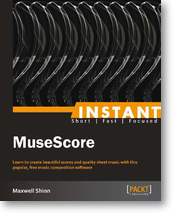I make no secret of my love for MuseScore–the free, open-source music notation software that has pretty much completely replaced Sibelius on my computer (and Sibelius was itself a welcome replacement for Finale, if that tells you anything). I’ve used MuseScore to make accordion sheet music, custom exercise handouts for my students, jazz lead sheets for my piano gigs, and even full string arrangements for my wife’s quartet.
Well, I guess the folks at Packt Publishing must’ve gotten wind of my fanboyishness, because they kindly sent over a copy of Maxwell Shinn’s eBook “Instant MuseScore“ for me to take a look at.
 The book is positioned as a quick, get-your-feet-wet type of guide. Shinn deftly walks the reader through the basics of downloading the software, installing it, then creating a new, multi-instrument score, pointing out some of the common (trust me!) pitfalls along the way. It’s an easy, breezy read–just enough to get you going in the right direction.
The book is positioned as a quick, get-your-feet-wet type of guide. Shinn deftly walks the reader through the basics of downloading the software, installing it, then creating a new, multi-instrument score, pointing out some of the common (trust me!) pitfalls along the way. It’s an easy, breezy read–just enough to get you going in the right direction.
Which puts the book in a difficult spot. There are plenty of free resources out there on the internet to help the MuseScore beginner get started, most notably Katie Wardrobe’s excellent set of YouTube videos that are linked right on the MuseScore’s own home page and which cover much of the same ground that Shinn does.
That said, I did learn a some new tricks from “Instant MuseScore” (eight of them, to be precise… I kept track as I read). So the book is definitely bringing something to the table.
But when you consider the price (Amazon currently offers the Kindle version for $7.99) along with the thin size of the book (probably less than 40 pages of genuine content), it’s a tough sell. Especially to a market that’s used to “free” from the outset. In that light, I think the book would probably benefit from either a slightly lower, “impulse buy” price level, or by having a bit more content–perhaps covering numbered endings, codas, styles, and more advanced format tweaking.
Still, I’m glad to see MuseScore getting some attention from professional publishers. Hopefully it’s the start of a trend!

